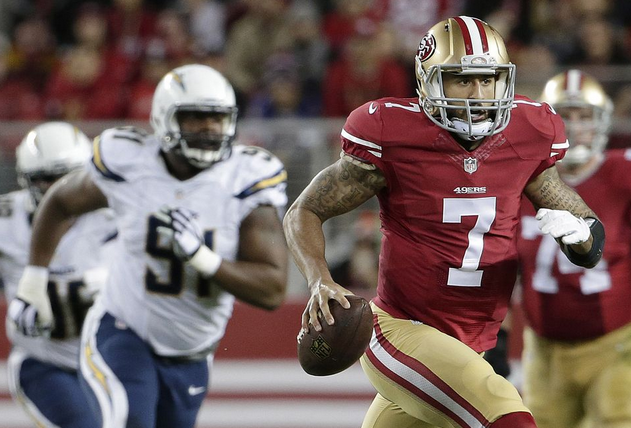It’s nice if an NFL quarterback can move around a bit, but being able to take off and run has never been a high priority. The position has always been, first and foremost, about throwing the ball.
The game evolves, though. And it’s reasonable to wonder, with the recent influx of several mobile quarterbacks, whether the definition of The Perfect QB will eventually change, too. A decade from now, will the paradigm be more of a hybrid player, a combination passer-runner who can throw darts and also operate the read-option?
The instant success of the Seahawks’ Russell Wilson, the 49ers’ Colin Kaepernick and the Redskins’ Robert Griffin III, all of whom made the playoffs in their first season as a starter, gave even more momentum to the 21st Century Quarterback idea. And last year Cam Newton, another dual threat, guided the Panthers to a 12-4 record and the NFC South title.
But in 2014 only Wilson has escaped the barbs of critics and the wrath of his fan base. Defenses have gotten better at dealing with some of the college-y stuff these quarterbacks do, and now it’s up to the QBs (and their coordinators) to adjust. Adapt or die.
The jury is very much out on whether they can . . . or even — as far as some coaches are concerned — want to. One of the problems with having a quarterback with unusual talents is that if you build a special offense for him, what happens if he gets hurt? Do you have a second QB with unusual talents who can step in, or do you have to go back to a more conventional attack? And can a team be successful switching gears like that?
You might be interested to know that the five running-est quarterbacks in modern history — I’m going by rushing yards per game — are all active, as you can see in this chart:
MOST RUSHING YARDS PER GAME BY A QB (SINCE 1945)
[table width=”550px”]
Years,Quarterback,Team(s),Yds,YPG
2001-14,Michael Vick,Falcons\, Eagles\, Jets,6\,010,43.9
2011-14,Cam Newton,Panthers,2\,457,41.0
2012-14,Robert Griffin III,Redskins,1\,461,40.6
2012-14,Russell Wilson,Seahawks,1\,782,38.7
2011-14,Colin Kaepernick,49ers,1\,513,32.2
1985-01,Randall Cunningham,Eagles\, Vikings\, 2 others,4\,928,30.6
1969-78,Bobby Douglass,Bears\, Chargers\, 2 others,2\,654,29.2
1999-09,Daunte Culpepper,Vikings\, Dolphins\, 2 others,2\,652,25.3
1985-99,Steve Young,Bucs\, 49ers,4\,239,25.1
2006-11,Vince Young,Titans\, Eagles,1\,459,24.3
[/table]
(Minimum: 32 starts.)
Granted, these averages usually decline as the quarterbacks get older, but they’re worth noting nonetheless.
Still, there’s no getting around the fact that 12 of the 14 Super Bowls in the 2000s have been won by QBs who weren’t much of a running threat at all. Only Wilson (2013) and the Packers’ Aaron Rodgers (2010) have had wheels worth worrying about (or as I like to refer to them, WWWAs).
RUSHING YARDS PER GAME BY SUPER BOWL-WINNING QBS (2000S)
[table width=”550px”]
Years,QB (Super Bowl Wins),Team,Yds,YPG
1999-14,Peyton Manning (1),Colts\, Broncos,678,2.7
2004-14,Eli Manning (2),Giants,465,2.8
2001-14,Drew Brees (1),Chargers\, Saints,684,3.4
2000-14,Tom Brady (3),Patriots,804,3.9
1994-08,Brad Johnson (1),Vikings\, Redskins\, 2 others,657,3.7
2008-14,Joe Flacco (1),Ravens,625,5.7
1994-07,Trent Dilfer (1),Bucs\, Ravens\, 3 others,853,6.6
2004-14,Ben Roethlisberger (2),Steelers,1\,163,7.4
2005-14,Aaron Rodgers (1),Packers,1\,817,16.8
[/table]
Note: Figures don’t include today’s games.
When you scan down these charts, you can understand why some coaches look at Wilson and the other passer-runners and say, “Who needs ’em?” The ones who don’t, though, the more open-minded types like Pete Carroll and Jim Harbaugh, have a chance to take pro football in a new direction. This is a healthy thing, of course. Without it, offenses would still be running the single wing and punting on first down.
Source: pro-football-reference.com

